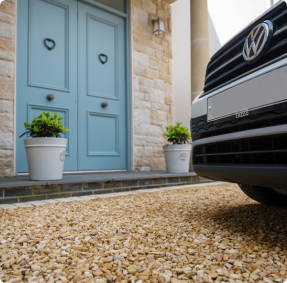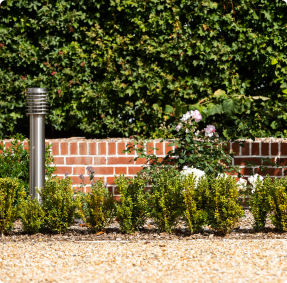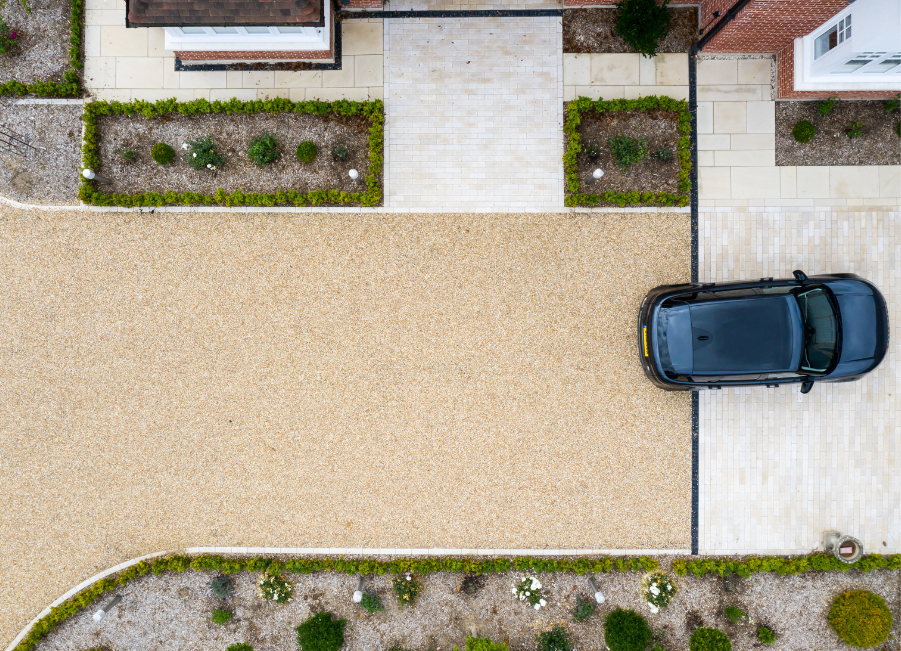What causes gravel migration?
Without the right landscape system, things like car wheels, footfall and rain can all cause the gravel on a gravel driveway to shift and end up where it shouldn’t be. Careless driving or allowing wheels to spin can kick up gravel causing ruts and an uneven gravel driveway surface. Pushchairs or wheelbarrows can cause displacement, while heavy rain can also result in gravel being washed away.
How do Gravelrings grids prevent gravel from moving and migrating?
Our Gravelrings gravel driveway grids are designed to hold gravel in place and stop it migrating to other areas, as well as preventing rutting and thinning. The interlocking grids feature a 25mm-deep cellular structure with an integral mesh base. They are designed to be overfilled so they remain out of sight while providing hidden stability beneath the gravel driveway surface. These features combine to prevent the shifting and sinking of the gravel aggregate.
What prevents the grids from moving, lifting and being seen?
Gravelrings gravel grids are just 25mm deep and are designed to be overfilled, so not only does the gravel stay in place on the driveway, but the grids themselves remain hidden. They also have an integral mesh base that prevents gravel from working its way beneath the grid system, so the grids don’t rise or create an uneven gravel driveway surface.
How easy is it to lay Gravelrings panels?
Gravelrings gravel retention grids are each 500mm2 and are delivered pre-assembled in 1m2 sheets, so they are quick and easy to lay. The simple clipping mechanism means a large area can be covered in a short period of time. Gravelrings landscape products also interlock seamlessly with our Grassrings grass protection system.
What ground preparation is required before laying Gravelrings gravel retention panels?
The gravel driveway should first be excavated to the correct depth. With Gravelrings, this will be less than other landscape systems, thanks to its low profile. Then lay a heavy-duty geotextile fabric, such as the Drivetex driveway membrane from Growtivation’s Product That Works range, to prevent aggregate settling into the soil beneath (the main cause of sinking and rutting). A compacted, level and firm sub-base material (MOT Type 1 aggregate or Type 3 for porous, SUDS-compliant installations) should then be laid to an appropriate depth for the intended traffic. The last step is to blind the surface with a 5-10mm layer of sharp sand or granite fines. Your gravel driveway surface is now ready for the Gravelrings panels to be laid.
Can Gravelrings be cut to fit around the contours of a space?
Yes. Gravelrings gravel driveway grids can be cut to shape easily and quickly using the correct tools and safety measures, allowing you to achieve full coverage of the space to be gravelled.
Can the Gravelrings gravel retention system be used on slopes?
Yes, where the slope has a gradient of no more than 1:5 (20%). The flexibility and low 25mm profile of Gravelrings means the landscape system follows the ground’s contours, and with pre-drilled holes can also be fixed in place using Gravelrings fixing pins.
How can you mark out parking bays on a gravel car park?
It’s easy with Gravelrings parking bay markers. These square modules push quickly and securely over the Gravelrings grid retention system, allowing you to mark out parking spaces on a gravel driveway or other gravel surface. They can be positioned in a range of formations to mark bay corners or delineate other areas. Gravelrings parking bay markers are available in white as standard, though other colour options are also available on request.
Are Gravelrings permeable and SUDS-compliant?
Yes. A gravel driveway or other gravel surface installed using the Gravelrings gravel grid system is fully permeable and SUDS-compliant. The integral mesh base of the gravel panels holds gravel in place but allows water to soak through the gravel driveway surface and into the ground.
Are Gravelrings gravel panels environmentally-friendly?
We’re committed to producing landscaping systems that don’t compromise the natural environment. Made from 100% recycled plastic*, Gravelrings landscape products adhere to low carbon principles and contribute to sustainability, creating more room for natural systems and less room for harmful carbon-intensive materials such as concrete. Gravelrings also reduce reflective heat and waterway contamination. *Black Gravelrings grids are made from 100% recycled material. White Gravelrings grids from part-recycled material.
Where can Gravelrings grids be used?
Gravelrings can be used wherever you need or want a gravel surface. The system is particularly suitable for landscaping schemes, gravel driveways and gravel pathways. It can also be used on sloped surfaces of less than a 1:5 gradient (20%).


























